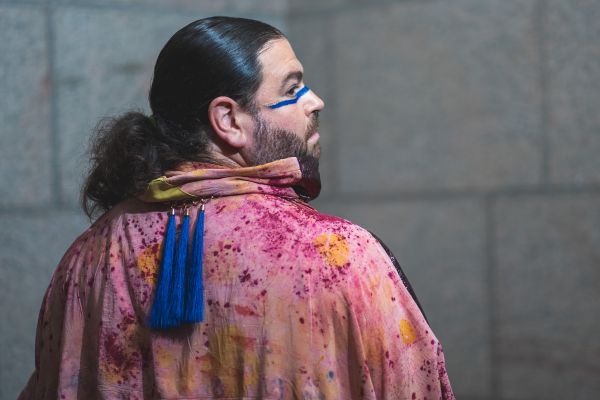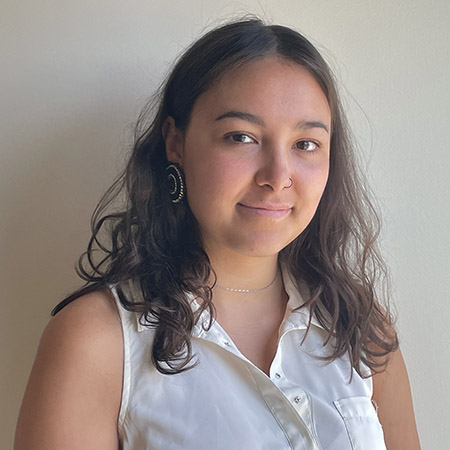
- Details
- By Neely Bardwell
What are you most excited to reveal in the collection?
Baerg: Last year, Ayimach Horizons honored the east, where sunrises and ceremonies begin. So fire was the element that we were honoring, and this year we moved down to the south, which acknowledges red, the summer, and earth metals. I met Melanie Monique Rose in Saskatoon about a year ago, and she works with the most beautiful botanical prints. We thought it would be a great way to honor Earth metal and the color red in the medicine wheel–to tell the stories of the land through botanical prints.
Rose: I’m really excited to share this collaboration on the runway in Santa Fe with Jason. These stories have been collected throughout the summer. For me, it’s been about building relationships with new plant relatives, learning how they can give us color through eco-printing, and how they can be used for medicine. I’ve really enjoyed learning about that, as well as sharing that with my family and Jason. I’m really excited to have those color stories from the land and bring them over here and share that with this audience.
Tell me a little about the process it took to create your collection.
Baerg: We started from that conceptual space of honoring red, the south, and earth metals. Then we wrote a grant. I submitted it, and thankfully we can acknowledge our funders, the Canada Council for the Arts. Then we had Melanie Monique come to Toronto. She visited with me and my family. My cousin Ethan took us on a medicine walk, and then we went to New York City. We then went back to Saskatchewan, where we offered a feast to the Métis community in Regina, and then we got to work. We presented eight looks back in my community, Big River, Saskatchewan. We really centered beautiful Indigenous people on the runway.
In what ways did your Indigeneity influence your designs?
Rose: I found that this whole process really connected me with my ancestors. I just felt there was a connection both forward and behind with me. So, as a Métis woman, it really connected me with the medicine women in my past who used these medicines, these plants for healing and food. Oftentimes, I might go out into the land thinking about a plant I want to find and another plant decides to want to meet me. It was that transmission of knowledge that I felt like I was reaching back to my grandmothers, and they’re saying, ‘Hey, we’ve left this here for you to learn about,’ and I found that very profound and touching. I was able to share this process with my five-year-old daughter, and I just felt that that was a beautiful circle. I feel like that connected me both spiritually and culturally with my mom and who I am
What does Indigenous representation in fashion look like to you?
Rose: There’s been so much cultural appropriation in fashion, and I just absolutely love that I get to be in this space, and I get to be inspired by all the incredible artists who are pushing Indigenous fashion forward, and to me, it’s way forward — it’s storytelling. It’s a way we can tell our stories.
Baerg: I think about the body as a metaphor for everything. I really appreciate the opportunity to celebrate people and honor them, and help them to rise as well. I think Indigenous representation in fashion grants us that opportunity to elevate our people, to celebrate our people, to celebrate our cultures. I’m really grateful for the people that have stepped forward and honored us by participating in the work. It was really, really amazing for me to see my mother in Vogue magazine. She lost her mother; her mother went to a residential school. She lost her mother when she was 19, and so she helped raise her siblings. She had four kids by the time she was 28; she was a single mom, and she has given all of her life. She’s been an incredible role model for so many people. Indigenous representation is so important.
What are you hoping people take away from your collection?
Rose: I’m hoping that there’s a wonder and curiosity of the abundance that the Earth gives us. How many people are familiar with plants and natural dyes? That’s the original way that we dyed; we put color on everything. I want more people to learn about these sustainable practices because the textile industry, especially dyes, is one of the largest polluters in the world. What I want is to really help people to see that abundance because there’s this lie that we keep on being told about scarcity, and I believe that the Earth has so much abundance, and there’s so much to give us. In turn, that gives us this want to protect, hold sacred, build relationships and have relationality to the Earth. I just hope that it inspires people to get outside and put their face in some plants and, you know, squeeze their fingers to some plants or open up a book and learn about how that plant can help them, and how they can help that plant.
Baerg: I’ve always loved fashion. I just think it’s so dynamic. I just hope people feel great energy from the work and they embrace actually being people that step into space, activating fashion in a generous spirit. I hope they take great inspiration and it just charges people to be their biggest, most powerful self.
More Stories Like This
Zuni Youth Enrichment Project and Partners at Ho’n A:wan Productions Launch 8th Annual Delapna:we ProjectChickasaw Holiday Art Market Returns to Sulphur on Dec. 6
Center for Native Futures Hosts Third Mound Summit on Contemporary Native Arts
Filmmakers Defend ‘You’re No Indian’ After Demand to Halt Screenings
A Native American Heritage Month Playlist You Can Listen to All Year Long
Help us defend tribal sovereignty.
At Native News Online, our mission is rooted in telling the stories that strengthen sovereignty and uplift Indigenous voices — not just at year’s end, but every single day.
Because of your generosity last year, we were able to keep our reporters on the ground in tribal communities, at national gatherings and in the halls of Congress — covering the issues that matter most to Indian Country: sovereignty, culture, education, health and economic opportunity.
That support sustained us through a tough year in 2025. Now, as we look to the year ahead, we need your help right now to ensure warrior journalism remains strong — reporting that defends tribal sovereignty, amplifies Native truth, and holds power accountable.
 The stakes couldn't be higher. Your support keeps Native voices heard, Native stories told and Native sovereignty defended.
The stakes couldn't be higher. Your support keeps Native voices heard, Native stories told and Native sovereignty defended.
Stand with Warrior Journalism today.
Levi Rickert (Potawatomi), Editor & Publisher

